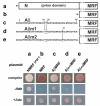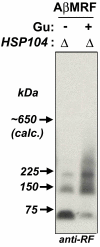Modulation of Abeta42 low-n oligomerization using a novel yeast reporter system
- PMID: 17002801
- PMCID: PMC1594584
- DOI: 10.1186/1741-7007-4-32
Modulation of Abeta42 low-n oligomerization using a novel yeast reporter system
Abstract
Background: While traditional models of Alzheimer's disease focused on large fibrillar deposits of the Abeta42 amyloid peptide in the brain, recent work suggests that the major pathogenic effects may be attributed to SDS-stable oligomers of Abeta42. These Abeta42 oligomers represent a rational target for therapeutic intervention, yet factors governing their assembly are poorly understood.
Results: We describe a new yeast model system focused on the initial stages of Abeta42 oligomerization. We show that the activity of a fusion of Abeta42 to a reporter protein is compromised in yeast by the formation of SDS-stable low-n oligomers. These oligomers are reminiscent of the low-n oligomers formed by the Abeta42 peptide in vitro, in mammalian cell culture, and in the human brain. Point mutations previously shown to inhibit Abeta42 aggregation in vitro, were made in the Abeta42 portion of the fusion protein. These mutations both inhibited oligomerization and restored activity to the fusion protein. Using this model system, we found that oligomerization of the fusion protein is stimulated by millimolar concentrations of the yeast prion curing agent guanidine. Surprisingly, deletion of the chaperone Hsp104 (a known target for guanidine) inhibited oligomerization of the fusion protein. Furthermore, we demonstrate that Hsp104 interacts with the Abeta42-fusion protein and appears to protect it from disaggregation and degradation.
Conclusion: Previous models of Alzheimer's disease focused on unravelling compounds that inhibit fibrillization of Abeta42, i.e. the last step of Abeta42 assembly. However, inhibition of fibrillization may lead to the accumulation of toxic oligomers of Abeta42. The model described here can be used to search for and test proteinacious or chemical compounds for their ability to interfere with the initial steps of Abeta42 oligomerization. Our findings suggest that yeast contain guanidine-sensitive factor(s) that reduce the amount of low-n oligomers of Abeta42. As many yeast proteins have human homologs, identification of these factors may help to uncover homologous proteins that affect Abeta42 oligomerization in mammals.
Figures







Similar articles
-
Key residues for the oligomerization of Aβ42 protein in Alzheimer's disease.Biochem Biophys Res Commun. 2011 Oct 28;414(3):512-6. doi: 10.1016/j.bbrc.2011.09.097. Epub 2011 Oct 2. Biochem Biophys Res Commun. 2011. PMID: 21986527
-
The HSP40 chaperone Ydj1 drives amyloid beta 42 toxicity.EMBO Mol Med. 2022 May 9;14(5):e13952. doi: 10.15252/emmm.202113952. Epub 2022 Apr 4. EMBO Mol Med. 2022. PMID: 35373908 Free PMC article.
-
α-synuclein-assisted oligomerization of β-amyloid (1-42).Arch Biochem Biophys. 2022 Mar 15;717:109120. doi: 10.1016/j.abb.2022.109120. Epub 2022 Jan 15. Arch Biochem Biophys. 2022. PMID: 35041853 Free PMC article.
-
Low-n oligomers as therapeutic targets of Alzheimer's disease.J Neurochem. 2011 Apr;117(1):19-28. doi: 10.1111/j.1471-4159.2011.07187.x. Epub 2011 Feb 9. J Neurochem. 2011. PMID: 21244429 Review.
-
Allosteric modulation of protein oligomerization: an emerging approach to drug design.Front Chem. 2014 Mar 24;2:9. doi: 10.3389/fchem.2014.00009. eCollection 2014. Front Chem. 2014. PMID: 24790978 Free PMC article. Review.
Cited by
-
Alzheimer's Disease: Significant Benefit from the Yeast-Based Models.Int J Mol Sci. 2023 Jun 6;24(12):9791. doi: 10.3390/ijms24129791. Int J Mol Sci. 2023. PMID: 37372938 Free PMC article. Review.
-
[NSI (+)]: a novel non-Mendelian nonsense suppressor determinant in Saccharomyces cerevisiae.Curr Genet. 2010 Oct;56(5):467-78. doi: 10.1007/s00294-010-0314-2. Epub 2010 Jul 29. Curr Genet. 2010. PMID: 20668856
-
Discovery of amyloid-beta aggregation inhibitors using an engineered assay for intracellular protein folding and solubility.Protein Sci. 2009 Feb;18(2):277-86. doi: 10.1002/pro.33. Protein Sci. 2009. PMID: 19177561 Free PMC article.
-
Antiparallel triple-strand architecture for prefibrillar Aβ42 oligomers.J Biol Chem. 2014 Sep 26;289(39):27300-27313. doi: 10.1074/jbc.M114.569004. Epub 2014 Aug 12. J Biol Chem. 2014. PMID: 25118290 Free PMC article.
-
Probing the role of structural features of mouse PrP in yeast by expression as Sup35-PrP fusions.Prion. 2012 Jul 1;6(3):201-10. doi: 10.4161/pri.19214. Epub 2012 Jul 1. Prion. 2012. PMID: 22449853 Free PMC article. Review.
References
Publication types
MeSH terms
Substances
LinkOut - more resources
Full Text Sources
Other Literature Sources
Medical
Molecular Biology Databases
Research Materials

